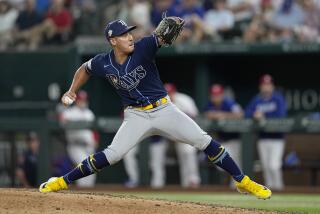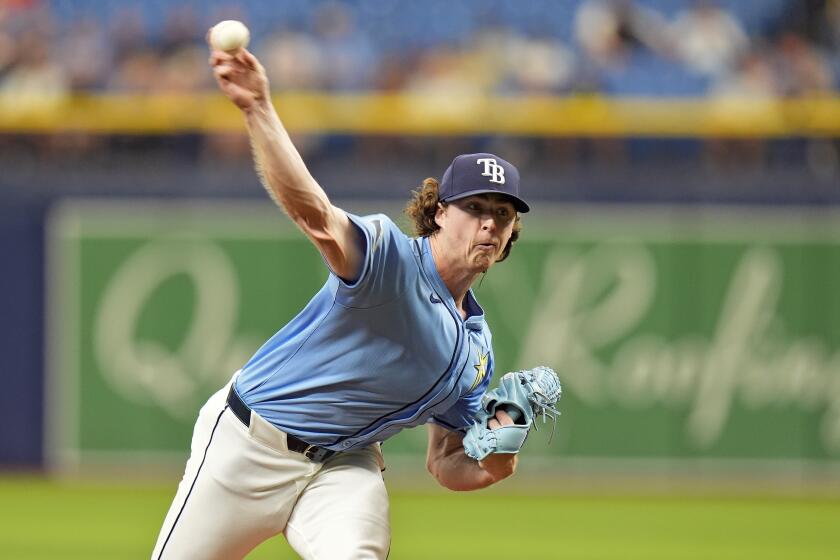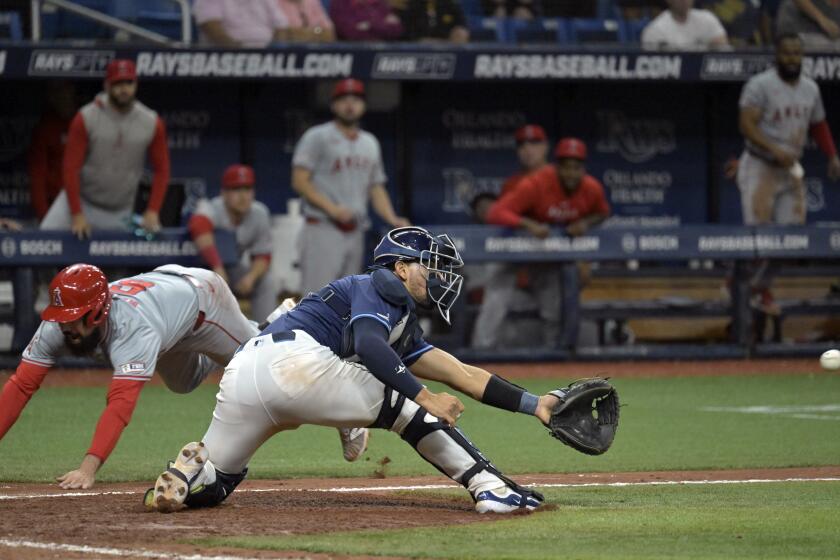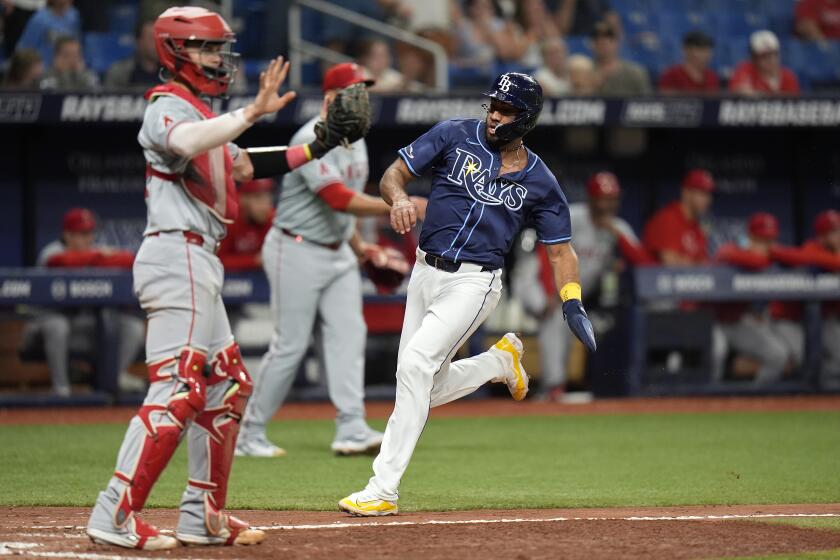Angels’ Garrett Richards hopes a return to his 2014 form can lead to big payday

Angels starter Garrett Richards throws during a bullpen session as Manager Mike Scioscia and teammate Jered Waver watch on Feb. 19.
Garrett Richards has entered the stage of his professional career where pitchers often come to terms with teams on long-term contracts.
Richards, 27, has recorded a 3.18 earned-run average in 376 innings the last two seasons, statistics similar to those posted by Stephen Strasburg and Jordan Zimmermann in the same span.
The Angels control the rights to the right-hander for three more seasons and will pay him $6.43 million this year. Their new general manager, Billy Eppler, has described Richards as the team’s ace.
Yet, the Angels have not had a conversation with Richards or his agent about a contract extension. The chief reason: There’s no consensus about what kind of pitcher Richards is and will be.
Until 2014, his baseball career had been defined by results unbefitting his abilities. In a pure upside play, the Angels selected Richards 42nd overall in the 2009 draft. The best ERA he had in three seasons at the University of Oklahoma was 6.00, but he threw hard and possessed a sharp slider.
While he rose through the farm system, Richards’ strikeout rate shrunk at each level. He performed capably but unspectacularly when the Angels inserted him into their rotation following Jered Weaver’s freak elbow injury in 2013.
The following season, 2014, was different. Richards struck out nearly a batter per inning, gave up just five home runs, and posted a 2.61 ERA until he sustained a torn tendon in his left knee on Aug. 20. After arduous rehabilitation, he returned to the majors eight months later and put up the second-best season of his career: a 3.65 ERA in 207 1/3 innings.
He was good, but not as good as the year before. His strikeouts shrunk again, his walk rate rose, and the homers increased.
So, the question that governs any extension beckons: Which season’s statistics present the more accurate Richards representation? As of now, Richards’ side can argue 2014, and the team can point to 2015.
“You might look at his stats and say that his ERA was a point higher,” said Angels left-hander Andrew Heaney, Richards’ winter throwing partner in Oklahoma City. “But then you can say that the dude didn’t have an off-season, came in and threw 200 innings and pitched the last game of the season for us. With all that, maybe his stats weren’t what they were, but when you’re talking about who gets paid, it’s people who are dependable in your rotation and throw 200 innings every single year.”
Richards said he never felt right last season. Particularly with his sinking fastball that darts in the opposite direction of his cutting fastball, he was uncomfortable completing his follow-through on his rehabilitated left leg. He threw the pitch 41% of the time to left-handed hitters in 2014, and 17% of the time in 2015, according to BrooksBaseball.net. He wants that to revert.
“There were games where I felt better than others, but it was a constant fight,” Richards said. “When I would land last year, my knee would give out, because it was weak. That would make my release point and my delivery a little bit different every time. Now that I have my lower half under me and I can repeat my delivery on that front side, I think it’s going to make me more consistent.”
Heaney thought Richards was lacking only in command last season. He said his teammate lost some trust in leaning on his lead leg. He also said those issues were absent during their off-season throwing sessions.
“I imagine he’s going to be the 2014 Garrett that everybody saw,” Heaney said.
There is no deadline for Richards’ negotiations. During the first week of last year’s regular season, four starting pitchers agreed to extensions with their clubs. All were right-handers ranging from age 23 to 28. The amount of team control that remained largely determined the money they were guaranteed.
Cleveland’s Carlos Carrasco, who was around the same service-time stage Richards is, signed for four years and $22 million. Boston’s Rick Porcello, two years later on the scale, signed for four years and $82.5 million.
Angels right fielder Kole Calhoun is another extension candidate. The 28-year-old will make $3.4 million in 2016.
The team has not approached him about a multi-year deal, either.
“With guys that are young and controllable who teams see for the future, that’s when you get locked up. It’s good for both sides. It would be awesome to come to an agreement,” Calhoun said. “But it’s a little touchy.”
Short hops
New Angels shortstop Andrelton Simmons has not yet played the field in Cactus League play because of soreness in his right arm. Manager Mike Scioscia plans to start him at shortstop Saturday, and Simmons may start at designated hitter Friday. …Third baseman Yunel Escobar made his Angels debut as the team’s leadoff hitter Thursday, and Scioscia indicated that is the regular-season plan. Calhoun could bat second, between Escobar and Mike Trout, or fifth, following Albert Pujols. … Angels minor league pitchers and catchers must report to camp by Saturday. Minor league games begin March 17.
Follow Pedro Moura on Twitter: @pedromoura
More to Read
Go beyond the scoreboard
Get the latest on L.A.'s teams in the daily Sports Report newsletter.
You may occasionally receive promotional content from the Los Angeles Times.







